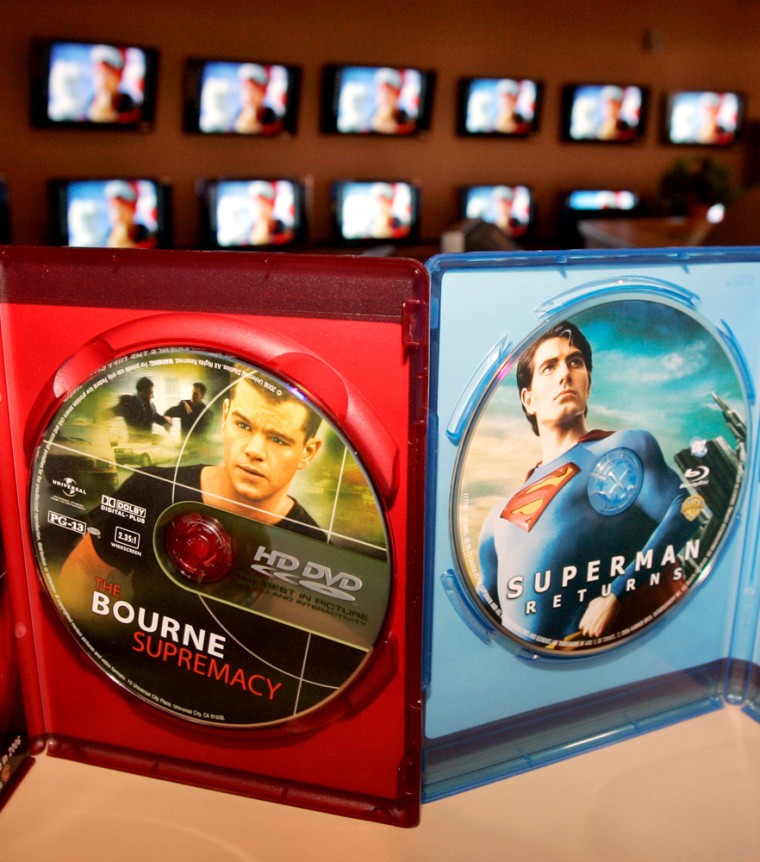You’ve got your HDTV up and running, you bought a high-definition DVD of the movie “2001: A Space Odyssey,” and you can’t wait to watch it.
To do that, though, you’re going to have to get a high-definition DVD player. No problem, you say.
Wrong. High-definition DVD technology has been retro, forcing consumers to choose one of two formats, Blu-ray or HD DVD, bringing back memories of VCRs and the VHS vs. Betamax wars.
That’s because movie studios and technology companies have lined up on two different sides of high-definition DVD technology.
“I’d like to spank both sides on the fanny because they left it up to the consumer, and they shouldn’t have,” said Dale Cripps, publisher and founder of HDTV magazine.
“Either way the consumer is facing some kind of loss, based on the choice they make: ‘If I choose Blu-ray, and it turns out that HD DVD sprints off to success, do I have movies and equipment that can play it?’ ”
Most movies are available in both formats. Still, you’re going to find yourself with an extra chore to do in the video aisle: doublechecking whether the movie you want is available in the format that will work with your high-definition DVD player.
And it helps to keep a scorecard of which movie studio is backing which format or both, something that seems to be changing every week.
Sony is limiting releases to Blu-ray only, for example; Universal’s movies are available only in HD DVD.
Blu-ray is backed by companies including Sony, Apple and Dell, and studios such as Disney and Twentieth Century Fox.
HD DVD has Toshiba, Microsoft and Intel behind it, with studio support from companies like Paramount and DreamWorks.
(Msnbc.com is a Microsoft-NBC Universal joint venture.)
Warner Bros. Studios previously backed both formats, but said Jan. 4 it will switch to Blu-ray exclusively later this year, continuing to release HD DVDs until the end of May.
Blockbuster announced last summer it would mainly carry Blu-ray rentals, limiting HD DVD to just some of its stores.
Sony’s PlayStation 3 comes with Blu-ray. Microsoft’s Xbox 360 has HD DVD.
If you don’t want to keep an Excel chart of who’s doing what, here are some basics about high-definition DVDs:
- A standard DVD player cannot play high-definition discs. However, both high-def DVD formats are backward-compatible and can play older DVDs. But you won’t be watching them in true high-def.
- Even with a high-definition DVD player, your HDTV set must have a HDMI connection to link the player to the TV and to watch films in their high-def glory. Newer HDTV sets have at least one HDMI connection; older sets use DVI connections.
- High-definition DVDs cost about $30 on average, about $10 more than standard DVDs.
- Blu-ray DVD players, priced at between $400 and $500 last year, are starting to dip into the $300-plus price range, and may continue to drop.
HD DVD players cost about $300. Christmas 2007 saw prices dip to $200 and $250.
In mid-January, Toshiba dropped the price on one of its HD DVD players, the HD-A3 to $149.99.
For consumers who don’t want to choose one format over the other, both Samsung and LG have come out with a “dual-format” Blu-ray/HD DVD player.
They’re pricey, at around $1,000. Look for other companies to follow suit, and for prices to drop.
Samsung started off in the Blu-ray only camp.
But, “clearly, there’s confusion in the marketplace about the formats,” said Dan Schinasi, HDTV product planning manager.
“We now offer a player for those who want the best of both worlds.”
The differences in the technology between Blu-ray and HD DVD are not major at this relatively early stage of the HD game. Each uses the same kind of blue-violet laser to create the discs. Blu-Ray discs hold 25 gigabytes on a single layer vs. 15 gigabytes for HD-DVD.
Either way, that’s a lot of capacity to provide the kinds of extra features consumers have come to expect from DVDs.
A lower-cost alternative to high-definition players are upconverting DVD players, which start at under $100.
Upconverting players require an HDMI connection on an HDTV, and play regular DVDs. The picture you’ll see is a better one that that provided by a standard DVD player. But you will not see it in high-def.
At least with an upconverting DVD player, said Cripps of HDTV magazine, “if I’m getting good enough performance out of it, I’ll never have to throw away any of my DVDs, like I had to do with all my videotapes.”
High-definition DVD players are referred to as “next-generation” players, and many consumers may prefer to wait before buying one.
“Standard DVD players and upconverting players are the majority of the DVD player market,” said Joe Bates, director of research for the Consumer Electronics Association.
“But we do expect that to change over the coming year. It’s a matter of time before the next-generation DVD players become the majority.”
